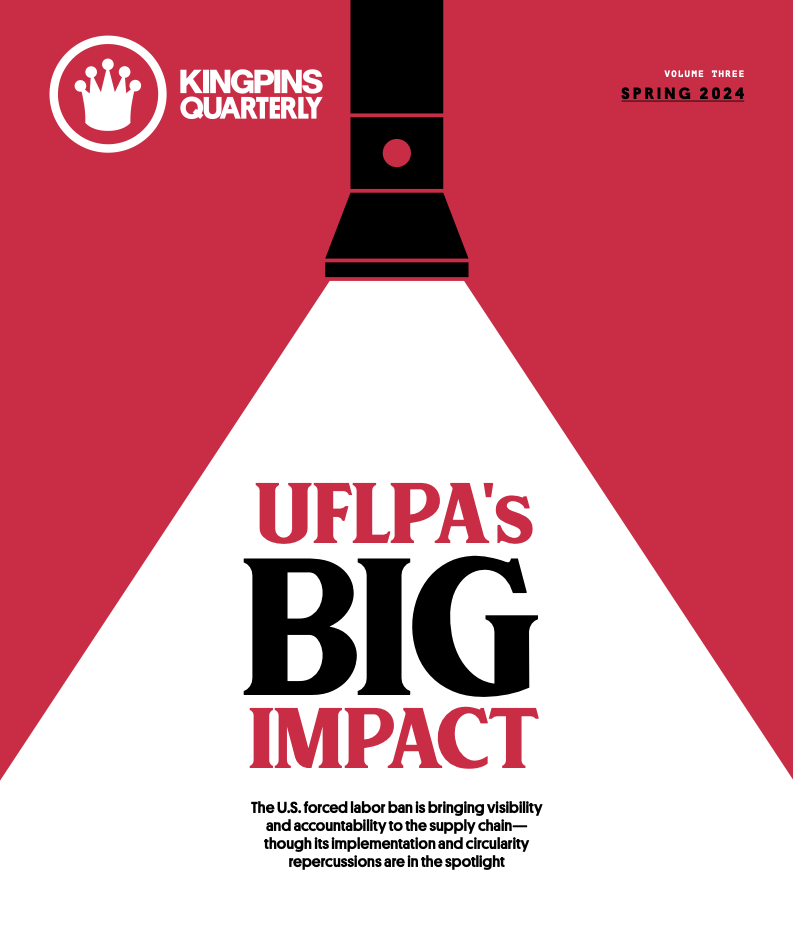As the climate crisis worsens, apparel companies are in a race to beat the clock. As it stands now, it seems clear time will run out on at least some of the industry’s 2025 goals. But, it’s not all bad news. Things are moving, mindsets are shifting and priorities are reshuffling—just slower than anyone would have hoped. The good news for 2030 targets is government intervention is on the horizon, and with it there’s the expectation that progress will accelerate. In the meantime, denim is grappling with the expectation of a mixed bag of wins and losses next year. As we look ahead, it’s time to analyze how this industry is pacing, how incoming regulations will transform operations, and the challenges even legislation alone won’t fix.
“The main reason for the industry to miss its targets is because adhering to them is not the priority in a growth fueled industry where prices are more important than value,” said Ebru Debbag, executive director of global sales and marketing for Pakistan-based denim mill Soorty. “Currently, there are no obvious detrimental consequences for not adhering to the mostly voluntary goals, however the EU proposal for a Directive Green Claims, Extended Producer Responsibility, the 35 new sustainability-related laws that will go in effect in the coming two to four years are on everybody’s radar.”
Debbag credits denim on its increased awareness and momentum around recycled content and next-gen materials but said the lack of a globally recognized set of rules and universal commitments to science-based targets is holding the industry back. Despite this, Soorty is moving forward with commitments to SBTs and a goal to reduce GHG emissions by 54.6 percent by 2030.
Abhishek Bansal, head of sustainability at India- based textile manufacturer Arvind, too applauds denim on its use of sustainable raw materials but he points out other areas of concern.
“Many leading brands and manufacturers are using up to 100 percent more sustainable materials. The denim industry has also made good progress in recycled materials in both cotton and polyester,” he said. “However, when it comes to a few other aspects, like decarbonization, the industry is still far likely to miss even [reaching its] 2030 goals. Progress on adoption of renewable energy needs to become broader based, both geographically as well as across different brands and suppliers.”
As Bansal illustrates, outcomes in 2025 will vary with some aspects of sustainability faring better than others. Similarly, every company is on its own journey, moving at its own pace.
“It’s a case-by-case basis if we were to look at the individual goals these companies are setting around their 2025 targets. Collectively, I would say the industry is behind towards reaching the 2030 goals in terms of where they should be by 2025,” said Lewis Perkins, president/CEO, climate solutions company Apparel Impact Institute (Aii), which is focused on helping the industry reduce its carbon emissions by half by 2030.
Specifically, he said, apparel is running behind on improving resource efficiencies and reducing carbon footprints. According to Perkins, the industry needs to be in the implementation phase throughout the supply chain. “Assessment, carbon calculation, roadmapping, and benchmarking… really was the work that started happening with some a decade ago, others five years ago. If you’re just getting started at that level, you need to play catch up,” he said.
V. Besim Ozek, strategy and business development director for Turkey-based denim mill Bossa, said his company is on track with its goals, which he committing to ESG improvements shores up its financial sustainability. “Whenever we decrease the carbon footprint, that means we are paying less for energy,” he said.
Overall, Ozek said for all its shortfalls, denim is leading the apparel industry. “Denim industry awareness is a lot better than other textile products,” he said “In my previous career, I used to work in other textile areas. I can easily say that denim has the most green production.”
Even within the denim category, there are “bright spots,” according to Frank Zambrelli, managing director, global ESG retail at business consultancy Accenture.
“We’ve seen a significant acceleration of actual publicly facing commitments; science-based targets that have increased hundreds fold in just the last two years; the adoption of some more advanced pilots in certain areas of some of that value chain activity, specifically on GHG reduction; dynamic progress—and the brightest spot of course—in the scope one and scope two,” he said.
Zambrelli said regulation will be the next major accelerant.
Regulation Impact
Until now, goals have been voluntary, with few real- world business ramifications if they were missed, including reputational damage at the consumer level and greater scrutiny from those investors that are attempting to decarbonize their portfolios. With the tidal wave of sustainability laws making their way through their respective legislatures in the U.S. and EU, that’s about to change. There will be punitive consequences for businesses that don’t meet at least the minimum mandated requirements.
As with any new law, there’s a fear factor, but Zambrelli said these new regulations are also validating, and already they’re helping to justify sustainability efforts. “What we’re starting to see is that it’s almost giving a freedom and elasticity— the flexibility to invest, the flexibility to actually change the processes that were long held, and the freedom with their boards to say, ‘we actually have to do this’,” he said.
Zambrelli said in the near future, companies will need to report their remediation outcomes to the investor community just as they answer to Wall Street on revenue. “So, what we’re starting to see is this shift to accountability in the operating model, and actually even some compensation structures tied to some of these larger, more publicly facing goals.”
Moving sustainability goals from voluntary to mandatory will also open the door to new investments, Perkins said.
“It’s going to bring more partners to the table. It’s going to incentivize a lot of philanthropic funders who can participate in lowering debt stacks or interest rates related to lending capital,” he said. “If we can signal the market towards the investments that need to be made in the supply chain, and there’s a de-risking of those relationships between brand/retailers and the suppliers, there are plenty of other financiers, funders, private equity, banks that are ready to step in.”
When it comes to regulation, Ozek of Bossa said governments should consider leading with the carrot and not the stick.
“We definitely need some governmental support. Governments may decrease the VAT ration if the final garment has got minimum 20 percent post- consumer recycled fiber content in the blending,” he said. “This will motivate all the brands for sure.”
Collective Action
Getting every brand, supplier and partner motivated and contributing to change could have the biggest impact on how denim will measure up to its commitments—and currently, that’s among the industry’s biggest challenges.
“There is significant collaboration across the global denim industry between individual companies that is driving the overall effort of the industry,” said Jimmy Summers, vice president – environment, health, safety, and sustainability and chief sustainability officer for Elevate Textiles, which is s comprised of a portfolio of brands including U.S.-based Cone Denim, which is on track to meet its 2025 goals. “We need to continue to collaborate and share information and approaches in ways and spaces that are mutually beneficial and positively advance the industry.”
While Bansal said Arvind has a few partnerships with customers that share the investment burden, the practice is not widespread enough to accelerate change.
“Collective action and burden sharing are lacking in the industry. Coupled with lack of aspirational goals, it makes the implementation slower,” Bansal said. “This is a global and collective problem; hence it needs collective action from all industry stakeholders, and collective investments and risk sharing. The problem is that it’s seen in many cases as a manufacturing problem, and burden to improve falls on the manufacturing industry.”
Bansal said pricing pressure and transactional sourcing relationships are major hinderances. “Direct investments in supply chain, as well as outcomes-based incentives would help in rapid action on the ground,” he said.
Debbag of Soorty agrees that the burden must be shared across supply partners. “Off-setting needs to transform into in-setting, where the funding goes directly to the operations linked to the supply chain,” she said, pointing to the collaboration between Bestseller and H&M for an offshore wind power project in Bangladesh as an example of what can be achieved. “The supply chain needs to transform into an understanding of supply system, where investments enable goals of individual partners as well as the whole.”
Zambrelli said his team is seeing more thinking along these lines, particularly from organizations that are on track with their own goals. They recognize their efforts alone won’t mitigate risk or bring on complete decarbonization.
“From the large organizations, from the public organizations, we’re seeing much greater collaboration, co-benefit models that are being created, investments that are being made, but also a level of conversation beyond just the supplier-brand partnership… to engage in elements that can help the system shift,” he said. “That’s just good business. If you don’t get involved in changing tier four as a major denim company, you’re going to risk volatility and supply in a very short number of years.”
Perkins said there are still some CFOs who fail to recognize the need for investing in the supply chain. To that end, Aii has established the Fashion Climate Fund, which allocates resources toward decarbonization by region and by clusters so brands are investing in suppliers that they have a direct interest in.
“The companies that aren’t [participating], it does tend to be a lack of either understanding or just their philosophy on whether or not they believe it’s their role to subsidize suppliers in this work,” Perkins said, adding incentives can take on a lot of different forms, including being recognized as a preferred vendor based on achieving pre-set goals. “Sure, [suppliers] would love lower interest rate loans… but ultimately, they’d be willing to take on a lot of personal investment from their own corporate treasury or partner with financial institutions if they have that line of sight towards longer-term purchasing agreements or commitments to volume.”




